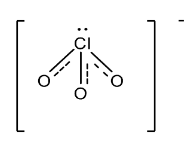Question
Question: Explain the hybridization of the central atom in \(Cl{{O}_{3}}^{-}\)....
Explain the hybridization of the central atom in ClO3−.
Solution
The hybridization can be calculated with the number of valence electrons of the central atom, number of monovalent atoms/ groups surrounding the central atom, charge on the cation, and charge on the anion.
Complete step by step answer:
Hybridization is defined as the mixing of the atomic orbitals belonging to the same atom but having slightly different energies so that redistribution of energy takes place between them resulting in the formation of new orbitals of equal energies and identical shapes. The orbitals thus formed are known as hybrid orbitals.
In ClO3− ion the central atom is chlorine and it is surrounded by three oxygen atoms. It has one lone pair.
For calculating the number of hybrid orbital or hybridization of central atom we can use the formula:
X=21no. of valence electrons of central atom !!!! + !!!! no. of monovalent atoms !!!! !!!! charge on cation !!!! + !!!! charge on the anion !!!! -
X=21[VE+MA−c+a]
So, in ClO3− the central atom chlorine has 7 valence electrons.
There is no monovalent atom present in ClO3− . Oxygen is a divalent atom.
There is no cationic charge on ClO3−.
The anionic charge on ClO3− is 1.
So, by putting all these in the equation, we get
X=21[7+0−0+1]=28=4
The value of X is 4, therefore, the hybridization is sp3 .
The structure of chlorate ion (ClO3−) is given below:

Because of sp3 hybridization the structure of chlorate ion (ClO3−) is predicted to be tetrahedral but the actual structure of chlorate ion is pyramidal. This is because of the presence of one lone pair.
Note: Only monovalent atoms can be considered. For divalent ion, MA = 0. By calculating the hybridization the structure can be predicted, but due lone pair the structure will get changed. So for predicting the shape, lone pairs should be considered.
